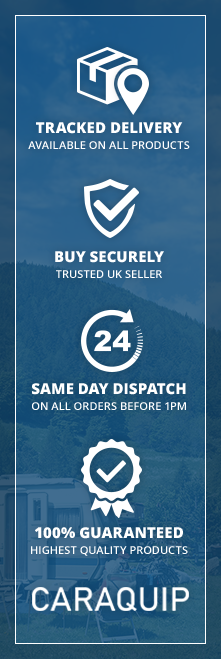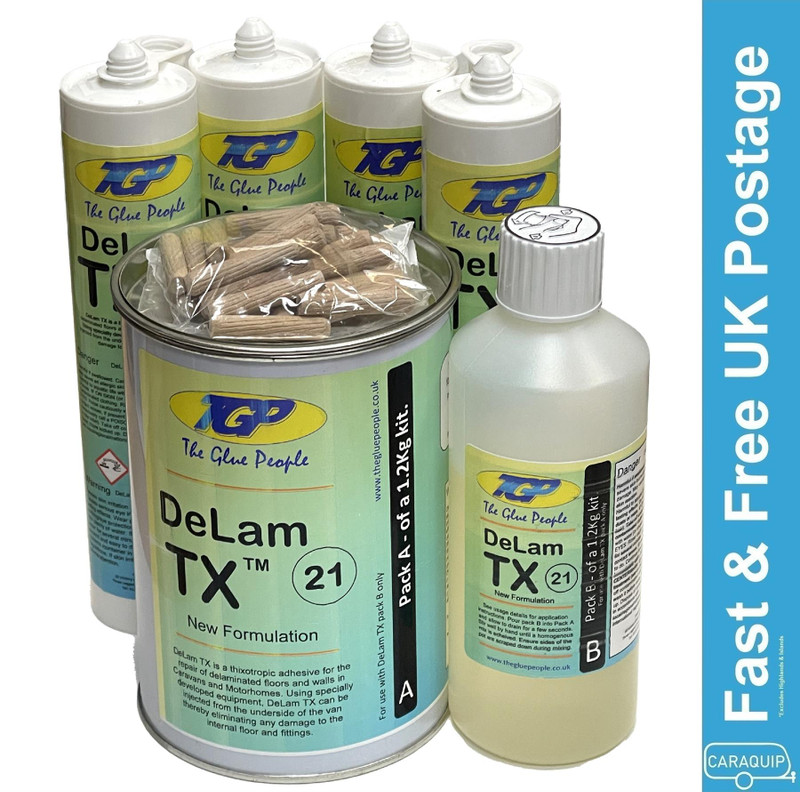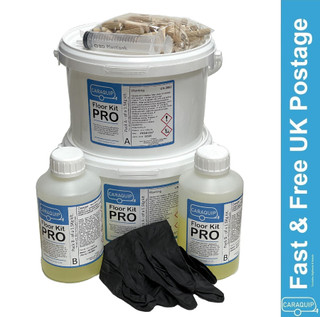Product Description
Caravan Floor Delamination Repair Kit Adhesive Damp Motorhome Static 1.2kg
The ONLY delamination floor repair kit that you use from underneath the vehicle
DeLam TX Floor kit is the one and only thixotropic (non-drip) epoxy resin floor delamination repair system for the professional caravan repairer.
Developed for injection from the underside of the caravan, DeLam TX eliminates the need to spend time removing furniture and fittings from inside the caravan / motorhome and negates the need to drill into any bonded floor coverings, saving the engineer time and energy!
DeLam TX is solvent free and safe on polystyrene and styrofoam. It can also be used to re-bond floors and walls in caravans, commercial vehicles and motorhomes, as well as portable and relocatable buildings.
DeLam TX only moves under pressure, so will stay where you put it.
INSTRUCTIONS
For best results, it is imperative that the delamination is treated as quickly as possible after it is first noticed, as constant trafficking of a delaminated floor will create dust and debris between the timber ply and the insulation material. The first part of the repair is to determine the extent of the damage. From inside the vehicle walk on the floor to determine how far the delamination has travelled. Mark the outer edges of the damage and then by careful measurement, transfer this information to the underside. Make certain the vehicle is high enough from the ground for ease of access and is secure and stable.
Drill a series of 8mm holes up into the floor and the insulation, to cover the entire affected area at 200mm centres and in a diamond pattern. Vacuum around the drilled holes and remove as much dust as possible from inside the holes.
Prepare the application kit by removing the small dome on the end of the cartridge threads, leaving the threads intact. The bendy nozzles can be quite tight, so adjust them to the angle you require now.
When all of the preparation work is complete mix the resin, Empty the entire B pack into the A pack, allow the B pack to drain for at least 10 seconds then mix thoroughly until a uniform colour is achieved. Do not attempt to mix part packs as the mix ratio is critical. The material will seem to thicken considerably during mixing, this is just the thixotrope reacting, and is normal. Although the material seems thick, it will pump very easily. Always wear gloves when working with chemicals.
Once mixed, place the follower plate on top of the resin and push down gently into the tin until all of the air is expelled. Place the cartridge over the hole in the follower plate and push down gentyly to fill the cartridge 20mm from the top and then place the plunger into the cartridge and carefully push it down on a flat surface to locate it correctly. If the resin starts to extrude because the gap at the top of the cartridge is insufficient, put a nozzle on for some extras space to avoid too much mess. It is best to fill all four cartridges at the same time.
Load the cartridge into a standard mastic gun, then push the nozzle into the first hole and inject the resin until it comes out of the next hole. Remove the nozzle and insert a dowel / bung into it's place, but leave a few holes without dowels . If it builds up a lot of pressure and refuses to pump, remove the probe, insert a dowel and go to the next hole. It probably means that the ply has not delaminated in that position. Work methodically across the van completing one line of holes at a time.
Alternatively, work around the delaminated area and work slowly towards the centre. When the injection is complete, immediately place some boards inside the vehicle; above the injected area and place some weights on them to bring the ply into contact with the insulation. This will probably displace some resin and push it back out through the holes, so ensure there is a dust sheet or other protective material under the van to catch it.
At 20°C the adhesive will be cured well enough the following morning to move the van. Plug the remaining holes with the dowels / bungs supplied. Do not clean around the hole first as any residual resin will help to bond the dowels into place.
Important Notes – Ensure that adhesive is not pressure injected too close to a joint in the floor panels as this could soak up into the carpet. When using in very hot temperatures; ensure resin, mixing vessels, substrates and ambient temperatures are below 20°C or pot life can be drastically reduced. DeLam TX has a specially controlled exotherm to keep heat build up to a minimum and to increase pot life. The mixed material will remain useable for at least 1 hour at 15°C.

















